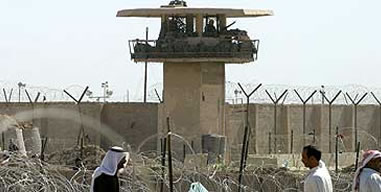Camp Ashraf was Rajavi’s ideal and practical milieu for thought reform techniques
As one among many of the psychological techniques used to control the minds of the insiders 
“The most basic feature of the thought reform environment, the psychological current upon which all else depends, is the control of human communication. Through this milieu control the totalist environment seeks to establish domain over not only the individual’s communication with the outside (all that he sees and hears, reads or writes, experiences, and expresses), but also – in its penetration of his inner life – over what we may speak of as his communication with himself. It creates an atmosphere uncomfortably reminiscent of George Orwell’s 1984.”
Initially, a place had to be found to meet Rajavi’s needed features for the thought reform environment, a place totally cut and isolated from the modern world. But Rajavi had already made his decision on the place even before the initiation of the ideological revolution when he met with Iraq’s Foreign Minister, Tariq Aziz, on 9 January 1983 in France. Consequently, grabbing at the granted opportunity to enhance close relations with Saddam and Iraq’s Baath Party, Rajavi made his flight to Iraq after the French government pressed the organization to leave the country’s soil. To justify his relocation to Iraq, Rajavi reportedly announced that he had decided to settle in Iraq as it was a strategic site to carry out operations aimed to overthrow Iranian regime.
He moved to Iraq at a time when the Iraqi forces had many kilometers of Iranian lands under their boots, a move that none of the opposition could tolerate. No doubt, MKO was empty handed when it arrived in Iraq in 1986 and in need of aid. Rajavi’s consequent meeting with Saddam and then with other Iraqi ranking officials followed with dollar allocations as well as granted military camps and logistics boosted a broad collaboration that lasted until the fall of Saddam. Settled in Iraq, the members were forced to stay on military compounds, the biggest one being Camp Ashraf.
In fact, when Saddam in 1986 granted Camp Ashraf to MKO, it was nothing more than a piece of wasteland as it is geographically the case with other parts of the region. But Saddam’s granted huge sums of money cut from the pocket of the Iraqi people, and Rajavi’s physical and psychological exploitation of his cult’s victims, turned the scorched piece of land into an oasis that none of the people around it had the right to enter nor to use. Nobody knows the many secrets behind this forbidden land; nobody knows the whereabouts of those who entered the mysterious stronghold and never came out; it is full of souls who are claimed to have died of unknown causes, suicides, heart or brain stroke, cancers and self-immolation. Under any brick and stone you can come upon scores of men’s lost lives, wills and wishes. And nobody forgets many instances of the confirmed unearthed mass graves reflected in the Iraqi media.
Once Dr. Ali Shariati, the late Iranian thinker, in one of his books entitled “Ye Brother, That’s The Way it Was” written soon after his return from Egypt, related the sad history of how the Great Pyramids had been built. He regretted that what people appreciated as wonders were the product of many victimized, oppressed people who had been brutally exploited by the pharaohs to build the wonders. Neither Rajavi is to be compared with the Pharaohs nor the Pyramids with the Ashraf nor the latter’s victims with the former’s. But, it is rather a shame to witness such things happening just in the modern third millennium. And the history is repeated just in the heart of Iraqi deserts where “the pearl of the desert”, as some locals call Ashraf, emerged out of some land hardly you can chance upon green life. It has been repeatedly stated that Rajavi is the one who has openly raised the slavery flag over his bastion with no clear objection to it. His victims are the laborers who are enslaved physically and psychologically; they have to work for him and worship him as well.
Besides providing an ideological bastion for cultic practices and total disconnection of the insiders from the outside world, MKO needed a strategic bastion as it was an armed organization at war with Iranian regime. Strategically, MKO needed a military base close to Iranian borders for training and a military depot for substantial munitions especially after the formation of the so-called National Liberation Army (NLA). And from a political point of view, MKO regarded Ashraf as the symbol of power and resistance in its propaganda campaign for certain reasons, to impress Iranian and non-Iranian supporters and western politicians and also to recruit new members by a superficial depiction of a utopia.

